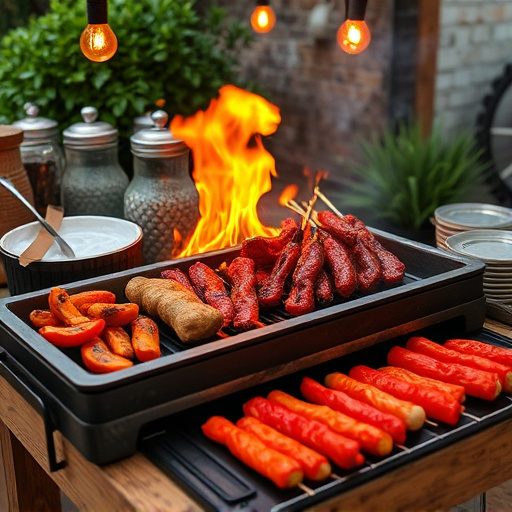Selecting the right cut of meaty, dark meat chicken legs with minimal fat is key for a delicious BBQ chicken legs recipe. Marinades and rubs enhance flavor and tenderness, while mastering grilling techniques ensures even cooking. The perfect BBQ sauce balances sweet, tangy, and savory notes, and internal temperature of 165°F (74°C) ensures juicy meat. Serving suggestions include crisp vegetables, hearty sides, and herbs for a complete meal that caters to various tastes and dietary restrictions. Presentation tips emphasize balancing quality chicken with rich sauce, and offering inclusive alternatives for dietary needs.
Unleash your inner chef with this comprehensive guide to crafting the perfect BBQ chicken legs, catering to both novice and expert cooks. From selecting the ideal cut of chicken to mastering grilling techniques and developing mouthwatering rubs, we’ll walk you through every step. Learn to balance flavors with marinades, sauces, and seasonings, ensuring the best possible result. Discover tips for precise temperature control and timing, plus side dishes and serving suggestions to elevate your BBQ experience. And don’t forget, our section on accommodating dietary needs ensures inclusivity for all. Get ready to impress with your BBQ chicken legs recipe!
- Choosing the Right Chicken Legs for Your BBQ
- Understanding Marine and Rubs: The Foundation of Flavor
- Master the Art of Grilling: Technique Matters
- Creating the Perfect BBQ Sauces: A World of Possibilities
- Tips for Timing and Temperature Control
- Side Dishes to Compliment Your BBQ Chicken Legs
- Presentation and Serving Suggestions
- Accommodating Dietary Restrictions: Making It For Everyone
Choosing the Right Chicken Legs for Your BBQ
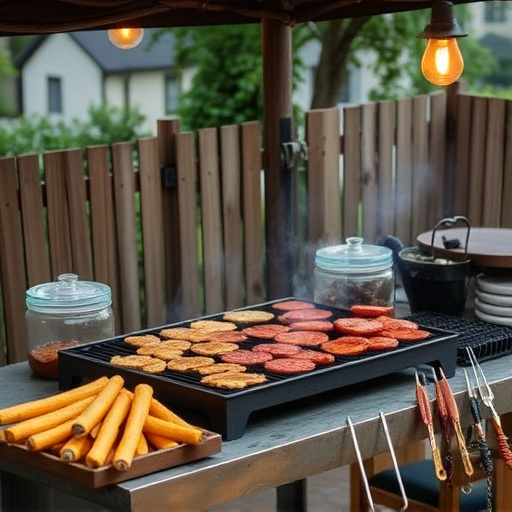
When it comes to mastering a delicious BBQ chicken legs recipe, selecting the right cut is key. Opt for whole chicken legs or drumsticks, which offer a hearty and flavorful experience for both novice and expert cooks. Look for meaty, dark meat with minimal visible fat; this ensures even cooking and prevents overcooking, resulting in tender and juicy legs. Avoid legs with excessive bone exposure, as these can be challenging to manage on the grill.
For a balanced BBQ chicken legs recipe, consider buying organic, free-range chickens if possible. These birds tend to have more flavorful meat and are raised with better standards of welfare, ensuring higher-quality ingredients for your dish. Additionally, marinating or rubbing the chicken legs before cooking adds depth of flavor, making them irresistible at any BBQ gathering.
Understanding Marine and Rubs: The Foundation of Flavor
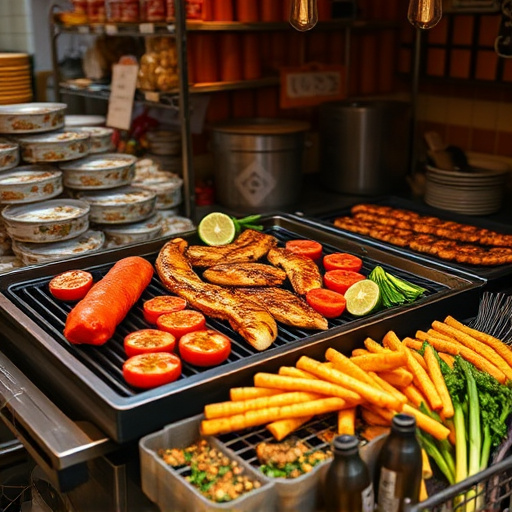
Understanding marinades and rubs is key to unlocking the full potential of your BBQ chicken legs recipe, whether you’re a novice or an expert cook. Marinades, with their combination of acids (like lemon juice or vinegar) and oils, penetrate meat fibers, softening it and enhancing its natural flavors. They can also help break down tough connective tissues, making your chicken legs incredibly tender. Rubs, on the other hand, are dry blends of spices that create a delicious crust on the exterior of the meat.
These flavorful additions don’t just make your BBQ chicken legs taste better; they also contribute to the overall cooking process. Marinades help equalize temperature during grilling, while rubs provide a barrier against overcooking, ensuring your legs remain juicy and tender. Whether you opt for a zesty citrus marinade or a robust spice rub, these techniques form the foundation of a truly exceptional BBQ chicken legs recipe that will impress both beginners and seasoned cooks alike.
Master the Art of Grilling: Technique Matters
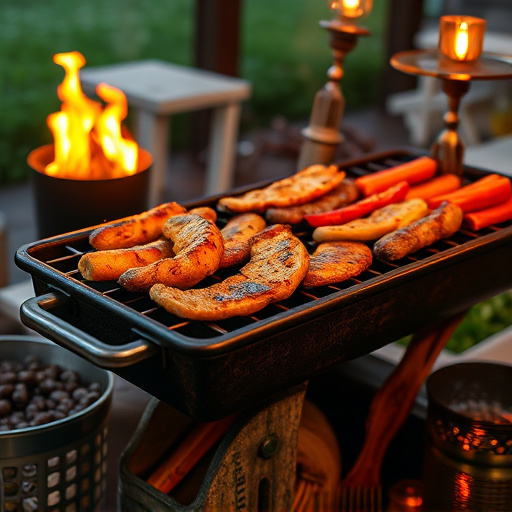
Mastering the art of grilling is a game-changer for any cook, especially those new to the BBQ scene. When it comes to a simple yet impressive dish like BBQ chicken legs, technique is key. The secret lies in achieving an even sear and slow cooking process for tender, juicy results. Start by preheating your grill to high heat, ensuring the coals are hot and evenly distributed. This initial step sets the stage for successful grilling.
For novice cooks, it’s essential to invest time in understanding direct and indirect heat zones on your grill. Direct heat is ideal for searing chicken legs to create a crispy exterior, while indirect heat allows for gentle cooking, ensuring the meat stays moist. A simple technique is to sear the legs directly over high heat for a couple of minutes on each side, locking in those delicious flavors, and then finish them off indirectly, letting the heat gently tenderize the meat.
Creating the Perfect BBQ Sauces: A World of Possibilities
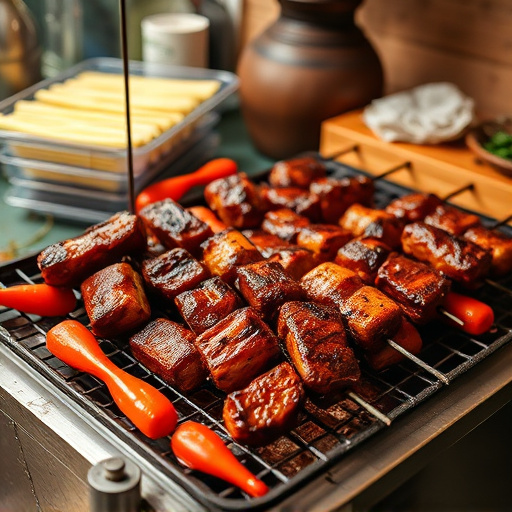
Creating the perfect BBQ sauce is an art that can elevate your barbecue game, whether you’re a novice or an expert cook. It’s all about finding the right balance of sweet, tangy, and savory flavors to complement your favorite grilled meats, especially juicy BBQ chicken legs. The world of BBQ sauces is vast, offering endless possibilities for experimentation. You can choose between thick, caramelized sauces with a smoky kick or lighter, fruit-based varieties that provide a burst of acidity.
For a classic approach, a simple blend of ketchup, brown sugar, vinegar, and spices like garlic powder and paprika will do the trick. For a more adventurous take, consider adding unique ingredients such as chili flakes for heat, mustard for depth, or even a touch of honey for that extra sweetness. Experimenting with different combinations allows you to craft a sauce tailored to your taste preferences, making every BBQ chicken legs recipe an exciting new adventure.
Tips for Timing and Temperature Control
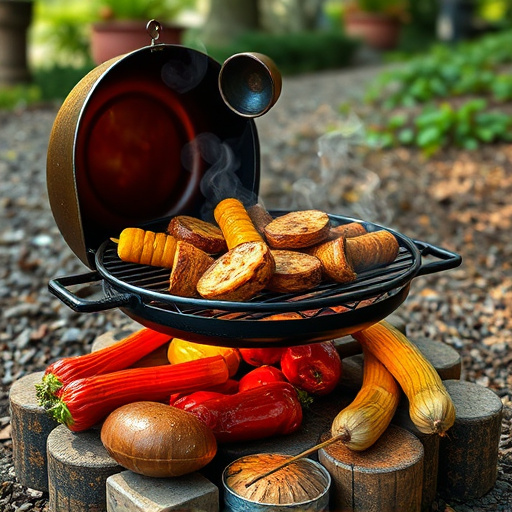
Timing and temperature control are key aspects that set apart a good BBQ chicken legs recipe from a great one. For novice cooks, starting with the right equipment is essential; a reliable thermometer and a good quality grill or oven will ensure precise results. The ideal internal temperature for juicy, tender chicken legs is 165°F (74°C), so use your thermometer to monitor the meat throughout the cooking process.
For expert cooks, knowing when to flip and baste becomes an art. A consistent cooking time of approximately 30-40 minutes will give you perfectly cooked legs, but timing can vary based on the heat source and size of the pieces. Regularly checking the temperature and using a gentle basting technique with your chosen BBQ sauce or marinade ensures a delicious finish, whether you’re grilling BBQ chicken legs or roasting them in the oven.
Side Dishes to Compliment Your BBQ Chicken Legs
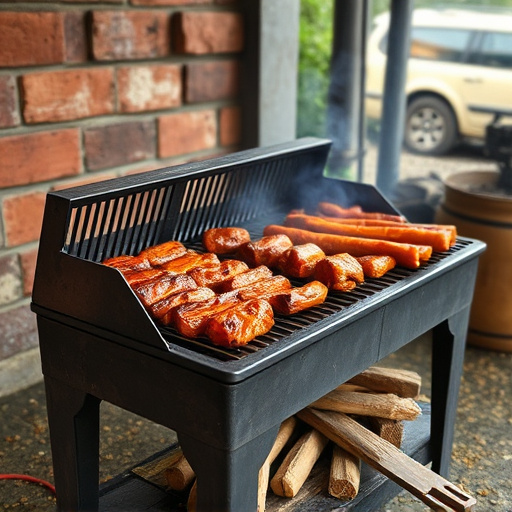
When serving BBQ chicken legs, side dishes that complement their smoky, savory flavor profile are key to a complete meal. Consider fresh, crisp vegetables like coleslaw or grilled corn on the cob for a refreshing bite. These options provide a great contrast to the rich, tender meat. For a heartier option, mashed potatoes or baked beans can stand up well against the bold BBQ flavors. Herbs and spices play a crucial role here; a sprinkle of chopped parsley or a dollop of sour cream can enhance the overall dining experience.
Don’t underestimate the power of simple yet effective pairings. Baked carrots or roasted Brussels sprouts with a drizzle of balsamic glaze offer both color and texture. For a summery touch, try a refreshing salad topped with a light vinaigrette dressing. These side dishes not only complete the meal but also cater to various tastes, making your BBQ chicken legs recipe suitable for novice and expert cooks alike.
Presentation and Serving Suggestions

When it comes to serving up a delicious BBQ chicken legs recipe, presentation is key. Start by arranging the cooked legs on a platter, ensuring they’re evenly spaced and coated with a generous glaze of your favorite BBQ sauce. Add a few sprigs of fresh herbs like rosemary or thyme for an aesthetic touch. You can also include side dishes like coleslaw, baked beans, or cornbread to complete the meal.
For novice cooks, simplicity is best; serve the chicken legs as they are for an easy-to-prepare yet impressive dish. Expert cooks, on the other hand, might consider adding creative twists—basting the legs with a homemade sauce while grilling, or serving them skewered for a visual appeal. Either way, the key to successful presentation is balance: let the quality of the chicken and the richness of the BBQ sauce do the talking.
Accommodating Dietary Restrictions: Making It For Everyone

When crafting a BBQ chicken legs recipe, it’s essential to keep in mind accommodating various dietary restrictions to ensure everyone can enjoy the dish. This means being mindful of common allergies and dietary preferences like gluten-free, vegan, or vegetarian needs. A simple solution is to offer alternatives for each component; use gluten-free flour for coating if necessary, and provide vegan options for the sauce by replacing ingredients like butter with plant-based alternatives.
For instance, a novice cook preparing this BBQ chicken legs recipe can easily adapt it to cater to guests with dietary limitations. They might opt for a drier rub without any sauces or use a different cooking method to ensure the chicken is still juicy and tender. Experts, on the other hand, can experiment with different marinades and glazes, creating unique flavors while accommodating diverse dietary needs, making it a versatile recipe that truly feeds everyone.
